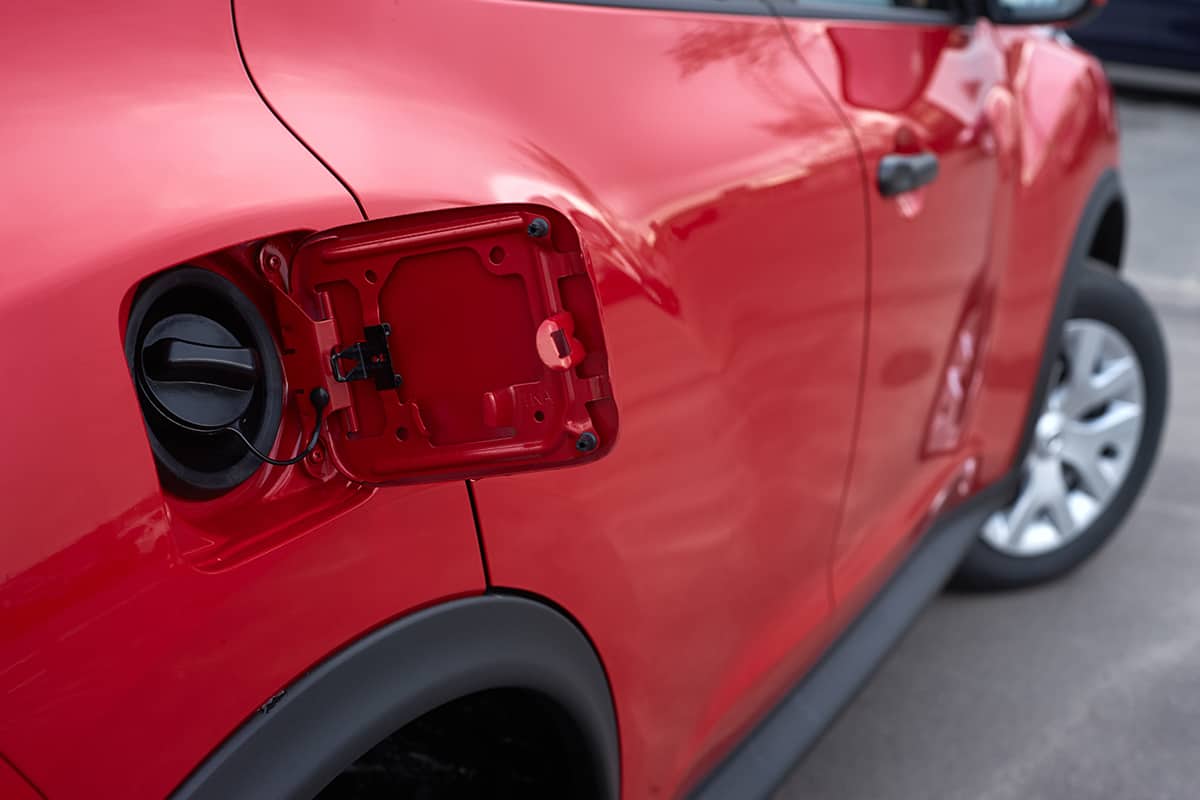Car gas tank sizes vary depending on the make and model of the vehicle. On average, a compact car’s gas tank can hold around 12 gallons, while a larger SUV or truck may have a gas tank that holds 20 gallons or more. The Hyundai Elantra’s gas tank is somewhere near the smaller end of the spectrum.
The 2023 Hyundai Elantra’s gas tank holds up to 12.4 gallons. This is much different from the 2020 model year, which could hold as much as 14 gallons of fuel per refill.
In this guide, I’ll describe the gas tank ratings and mileage specs of the Hyundai Elantra over the years, as well as explain why the size of the gas tank matters and how the gas Elantra compares to the electric version.
Hyundai Elantra Gas Tank Size
The Hyundai Elantra’s gas tank capacity has evolved in tandem with the vehicle’s various redesigns. Hyundai has made great strides in improving the Elantra’s fuel economy and driving range with each new model. This makes it an excellent option for both short trips and cross-country vacations.
The 12.4-gallon fuel tank in the Hyundai Elantra is a nice touch for such a stylish and up-to-date four-door. When comparing the three Elantra trims, the standard trim level has the highest fuel economy. With an estimated 37 MPG in the city and 42 MPG for highway driving, it outperforms the competition by a small margin. Combine that with the Elantra’s easy-to-use fuel economy (it can run on just 12.4 gallons of gas) and you have a vehicle that is both practical and enjoyable.
The base trim for the 2023 Elantra has a range of more than 450 miles. The driving range of all trim levels is significantly aided by the aforementioned 12.4-gallon gas tank capacity and the miles per gallon. When compared to the MPG offered by the base Elantra, the MPG offered by the SEL and Limited trims aren’t that far off.
The following table will describe the gas tank size and estimated mileage of the Hyundai Elantra starting from the first-generation model from 1990.
| Model Year | Gas Tank Size (gallons) | Combined Est. Mileage | Est. City Mileage | Est. Highway Mileage |
| 1990 | 15.9 | 21 MPG | 18 MPG | 26 MPG |
| 1991 | 11.9 | 26 MPG | 23 MPG | 31 MPG |
| 1992 | 13.7 | 22 MPG | 19 MPG | 26 MPG |
| 1993 | 13.7 | 22 MPG | 19 MPG | 26 MPG |
| 1994 | 13.7 | 22 MPG | 19 MPG | 26 MPG |
| 1995 | 13.7 | 22 MPG | 19 MPG | 26 MPG |
| 1996 | 14.5 | 24 MPG | 21 MPG | 29 MPG |
| 1997 | 14.5 | 24 MPG | 21 MPG | 29 MPG |
| 1998 | 14.5 | 24 MPG | 21 MPG | 29 MPG |
| 1999 | 14.5 | 24 MPG | 21 MPG | 29 MPG |
| 2000 | 14.5 | 24 MPG | 21 MPG | 29 MPG |
| 2001 | 14.5 | 25 MPG | 21 MPG | 30 MPG |
| 2002 | 14.5 | 25 MPG | 21 MPG | 30 MPG |
| 2003 | 14.5 | 25 MPG | 21 MPG | 30 MPG |
| 2004 | 14.5 | 24 MPG | 21 MPG | 29 MPG |
| 2005 | 14.5 | 26 MPG | 23 MPG | 31 MPG |
| 2006 | 14.5 | 24 MPG | 21 MPG | 29 MPG |
| 2007 | 14 | 28 MPG | 25 MPG | 33 MPG |
| 2008 | 14 | 28 MPG | 25 MPG | 33 MPG |
| 2009 | 14 | 28 MPG | 25 MPG | 33 MPG |
| 2010 | 14 | 29 MPG | 26 MPG | 34 MPG |
| 2011 | 12.8 | 32 MPG | 28 MPG | 38 MPG |
| 2012 | 12.8 | 32 MPG | 28 MPG | 38 MPG |
| 2013 | 12.8 | 32 MPG | 28 MPG | 38 MPG |
| 2014 | 13.2 | 28 MPG | 24 MPG | 35 MPG |
| 2015 | 13.2 | 28 MPG | 24 MPG | 35 MPG |
| 2016 | 12.8 | 32 MPG | 28 MPG | 38 MPG |
| 2017 | 14 | 33 MPG | 29 MPG | 38 MPG |
| 2018 | 14 | 32 MPG | 28 MPG | 37 MPG |
| 2019 | 14 | 33 MPG | 28 MPG | 38 MPG |
| 2020 | 14 | 34 MPG | 30 MPG | 40 MPG |
| 2021 | 12.4 | 37 MPG | 33 MPG | 43 MPG |
| 2022 | 12.4 | 37 MPG | 33 MPG | 43 MPG |
| 2023 | 12.4 | 37 MPG | 33 MPG | 42 MPG |
Source: Edmunds.com
From the table above, we can see that the most efficient model years for the Hyundai Elantra are 2021 and 2022, with just 1 additional mile per gallon on highways, despite their identical 12.4-gallon gas tanks.
Tank Size: Hyundai Elantra vs. Comparable Cars
Now, let’s see how the 2023 Hyundai Elantra compares to other family-oriented cars on the market.
| Make and Model | Gas Tank Size (gallons) | Combined Est. Mileage | Est. City Mileage | Est. Highway Mileage |
| 2023 Hyundai Elantra | 12.4 | 37 MPG | 33 MPG | 42 MPG |
| 2023 Audi A3 | 13.2 | 32 MPG | 28 MPG | 38 MPG |
| 2018 Ford Focus | 12.4 | 34 MPG | 30 MPG | 40 MPG |
| 2022 Honda Accord | 14.8 | 32 MPG | 29 MPG | 35 MPG |
| 2023 Honda Civic | 12.4 | 33 MPG | 30 MPG | 37 MPG |
| 2022 Hyundai Accent | 11.9 | 36 MPG | 33 MPG | 41 MPG |
| 2022 Hyundai Sonata | 15.9 | 31 MPG | 27 MPG | 37 MPG |
| 2023 Kia Forte | 14 | 34 MPG | 30 MPG | 41 MPG |
| 2020 Kia Optima | 18.5 | 29 MPG | 25 MPG | 35 MPG |
| 2014 Mazda 2 | 11.3 | 30 MPG | 28 MPG | 34 MPG |
| 2023 Subaru Impreza | 13.2 | 26 MPG | 24 MPG | 31 MPG |
| 2021 Subaru Liberty | 18.5 | 30 MPG | 27 MPG | 35 MPG |
| 2022 Subaru WRX | 16.6 | 22 MPG | 19 MPG | 26 MPG |
| 2022 Toyota Camry | 15.8 | 32 MPG | 28 MPG | 39 MPG |
| 2022 Toyota Corolla | 13.2 | 33 MPG | 30 MPG | 38 MPG |
| 2021 Volkswagen Passat | 18.5 | 28 MPG | 24 MPG | 36 MPG |
Source: Edmunds.com
As you can see from this chart, the 2023 Hyundai Elantra doesn’t sport the largest gas tank, but its estimated mileage ratings are superior to its alternatives.
Why Does Gas Tank Size Matter?
When looking for a car, it’s important to consider the size of the gas tank because it affects both the vehicle’s range and its fuel economy. Those who frequently drive long distances, or those who are taking a long trip, will find that a larger gas tank allows them to travel further on a single fill-up. Those who frequently travel long distances by car, whether for pleasure or work, may find this to be a significant time and cost savings at the gas station.
A smaller gas tank means you’ll have to fill it up more frequently, which can be inconvenient and costly. It’s annoying to have to stop so frequently to refuel when you’re in a rush or on a tight schedule. If money is tight, you should also consider how often you’ll need to fill up the tank and how much that will cost. For better trip preparation, budgeting, and vehicle selection, it is helpful to be aware of a vehicle’s maximum fuel capacity.
The size of a car’s gas tank may also determine how much cargo space is available. People who need to haul around large loads or have a lot of stuff that needs to be stored might want to think twice before buying a car with a huge gas tank.
Gas Elantra vs. Electric Elantra
If you’re contemplating purchasing a brand-new 2023 Hyundai Elantra, you might as well take a look at its electric counterpart, the Elantra Hybrid. Like any electric vehicle, the Hyundai Elantra is quiet, doesn’t produce any carbon emissions, and can cover a far distance on a single charge.
There are 2 trim levels available for the Elantra Hybrid—Blue and Limited. Here’s a quick breakdown of the mileage ratings for each trim.
| Parameters | Blue | Limited |
| Combined Est. Mileage | 54 MPGe | 50 MPGe |
| Est. City Mileage | 53 MPGe | 49 MPGe |
| Est. Highway Mileage | 56 MPGe | 52 MPGe |
In general, it can take roughly 3 hours to fully recharge the Elantra Hybrid’s battery from 10% to 100%.
Something you may find interesting is that the Elantra Hybrids have a much smaller MPGe difference between city and highway mileages (just 3 MPGe). Meanwhile, the gas version has a 9-MPG difference between city and highway mileage ratings.







